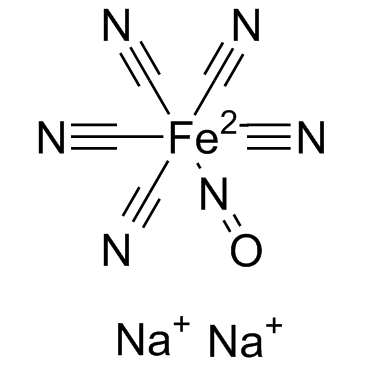14402-89-2
| Name | sodium nitroprusside |
|---|---|
| Synonyms | Nitroprusside (Sodium) |
| Description | Sodium Nitroprusside is a potent vasodilator working through releasing NO spontaneously in blood.Target: OthersSodium Nitroprusside is a potent vasodilator. Sodium nitroprusside has potent vasodilating effects in arterioles and venules. Sodium Nitroprusside breaks down in circulation to release nitric oxide (NO). NO activates guanylate cyclase in vascular smooth muscle and increases intracellular production of cGMP. The end result is vascular smooth muscle relaxation, which allow vessels to dilate [1]. Sodium nitroprusside decreases the proliferation of vascular smooth muscle cells [2]. Sodium nitroprusside (5 mg/kg) significantly reduces the intestinal ischemiareperfusion injury as a nitric oxide donor in rats [3]. |
|---|---|
| Related Catalog | |
| References |
| Density | 1.72 |
|---|---|
| Molecular Formula | C5FeN6Na2O |
| Molecular Weight | 261.91800 |
| Exact Mass | 261.92800 |
| PSA | 148.38000 |
| LogP | 0.29850 |
| Appearance | Liquid | Clear tan-gold |
Synonym:Disodium nitrosylpentacyanoferrate; nipride; nitroprussidnatrium;sodium nitroprussat Section 2 - COMPOSITION, INFORMATION ON INGREDIENTS
Risk Phrases: 28 36 Section 3 - HAZARDS IDENTIFICATION EMERGENCY OVERVIEW
Very toxic if swallowed. Irritating to eyes.Toxic. Potential Health Effects Eye: May cause eye irritation. Skin: May cause skin irritation. Ingestion: Harmful if swallowed. May cause irritation of the digestive tract. The toxicological properties of this substance have not been fully investigated. Inhalation: Dust is irritating to the respiratory tract. May cause cardiac abnormalities. Chronic: No information found. Section 4 - FIRST AID MEASURES Eyes: Flush eyes with plenty of water for at least 15 minutes, occasionally lifting the upper and lower lids. Get medical aid. Skin: Flush skin with plenty of soap and water for at least 15 minutes while removing contaminated clothing and shoes. Get medical aid if irritation develops or persists. Ingestion: If victim is conscious and alert, give 2-4 cupfuls of milk or water. Get medical aid immediately. Inhalation: Get medical aid immediately. Remove from exposure to fresh air immediately. If not breathing, give artificial respiration. If breathing is difficult, give oxygen. Notes to Physician: None Antidote: None reported Section 5 - FIRE FIGHTING MEASURES General Information: As in any fire, wear a self-contained breathing apparatus in pressure-demand, MSHA/NIOSH (approved or equivalent), and full protective gear. Extinguishing Media: For small fires, use dry chemical, carbon dioxide, water spray or alcohol-resistant foam. Autoignition Temperature: Not applicable. Flash Point: Not applicable. NFPA Rating: Not published. Explosion Limits, Lower: Not available. Upper: Not available. Section 6 - ACCIDENTAL RELEASE MEASURES General Information: Use proper personal protective equipment as indicated in Section 8. Spills/Leaks: Sweep up, then place into a suitable container for disposal. Avoid generating dusty conditions. Section 7 - HANDLING and STORAGE Handling: Wash thoroughly after handling. Wash hands before eating. Use only in a well ventilated area. Minimize dust generation and accumulation. Avoid ingestion and inhalation. Storage: Store in a cool, dry place. Section 8 - EXPOSURE CONTROLS, PERSONAL PROTECTION Engineering Controls: Use adequate general or local exhaust ventilation to keep airborne concentrations below the permissible exposure limits. Personal Protective Equipment Eyes: Wear appropriate protective eyeglasses or chemical safety goggles as described by OSHA's eye and face protection regulations in 29 CFR 1910.133. Skin: Wear appropriate gloves to prevent skin exposure. Clothing: Wear appropriate protective clothing to minimize contact with skin. Respirators: Follow the OSHA respirator regulations found in 29CFR 1910.134. Always use a NIOSH-approved respirator when necessary. Section 9 - PHYSICAL AND CHEMICAL PROPERTIES Physical State: Solid Appearance: clear dark red Odor: Not available. pH: Not available. Vapor Pressure: Not applicable. Vapor Density: Not available. Evaporation Rate: Not applicable. Viscosity: Not applicable. Boiling Point: Not available. Freezing/Melting Point: Not available. Decomposition Temperature: Not available. Solubility: 40% @ 20 C Specific Gravity/Density: 1.72 Molecular Formula: C5FeN6Na2O Molecular Weight: 261.8662 Section 10 - STABILITY AND REACTIVITY Chemical Stability: Stable under normal temperatures and pressures. Conditions to Avoid: Dust generation. Incompatibilities with Other Materials: Strong oxidizing agents. Hazardous Decomposition Products: Nitrogen oxides, carbon monoxide, carbon dioxide, toxic fumes of sodium oxide. Hazardous Polymerization: Has not been reported. Section 11 - TOXICOLOGICAL INFORMATION RTECS#: CAS# 14402-89-2: LJ8750000 LD50/LC50: CAS# 14402-89-2: Oral, mouse: LD50 = 61 mg/kg; Oral, rabbit: LD50 = 34 mg/kg; Oral, rat: LD50 = 99 mg/kg. Carcinogenicity: Sodium nitroprusside - Not listed by ACGIH, IARC, NIOSH, NTP, or OSHA. Other: See actual entry in RTECS for complete information. Section 12 - ECOLOGICAL INFORMATION For further information, contact Fisher Scientific. Section 13 - DISPOSAL CONSIDERATIONS Dispose of in a manner consistent with federal, state, and local regulations. Section 14 - TRANSPORT INFORMATION CDG/CPL Shipping Name: TOXIC SOLID, INORGANIC, NOS (Sodium nitroprusside) Hazard Class: 6.1 UN Number: 3288 Packing Group: II IMO No information available. IATA No information available. RID/ADR No information available. Canadian TDG Shipping Name: POISONOUS SOLIDS NOS (SODIUM NITROPRUSSIDE) Hazard Class: 6.1(9.2) UN Number: UN2811 Section 15 - REGULATORY INFORMATION European/International Regulations European Labeling in Accordance with EC Directives Hazard Symbols: T+ Risk Phrases: R 28 Very toxic if swallowed. R 36 Irritating to eyes. Safety Phrases: S 26 In case of contact with eyes, rinse immediately with plenty of water and seek medical advice. S 45 In case of accident of if you feel unwell, seek medical advice immediately (show the label where possible). WGK (Water Danger/Protection) CAS# 14402-89-2: Canada CAS# 14402-89-2 is listed on Canada's DSL/NDSL List. This product has a WHMIS classification of D1B, D2B. CAS# 14402-89-2 is not listed on Canada's Ingredient Disclosure List. Exposure Limits US FEDERAL TSCA CAS# 14402-89-2 is listed on the TSCA inventory. SECTION 16 - ADDITIONAL INFORMATION N/A |
CHEMICAL IDENTIFICATION
HEALTH HAZARD DATAACUTE TOXICITY DATA
|
| Hazard Codes | T: Toxic; |
|---|---|
| Risk Phrases | 25 |
| Safety Phrases | 45 |
| RIDADR | UN 3288 6.1/PG 3 |
| WGK Germany | 3 |
| RTECS | LJ8925000 |
| Packaging Group | III |
| Hazard Class | 6.1(b) |
